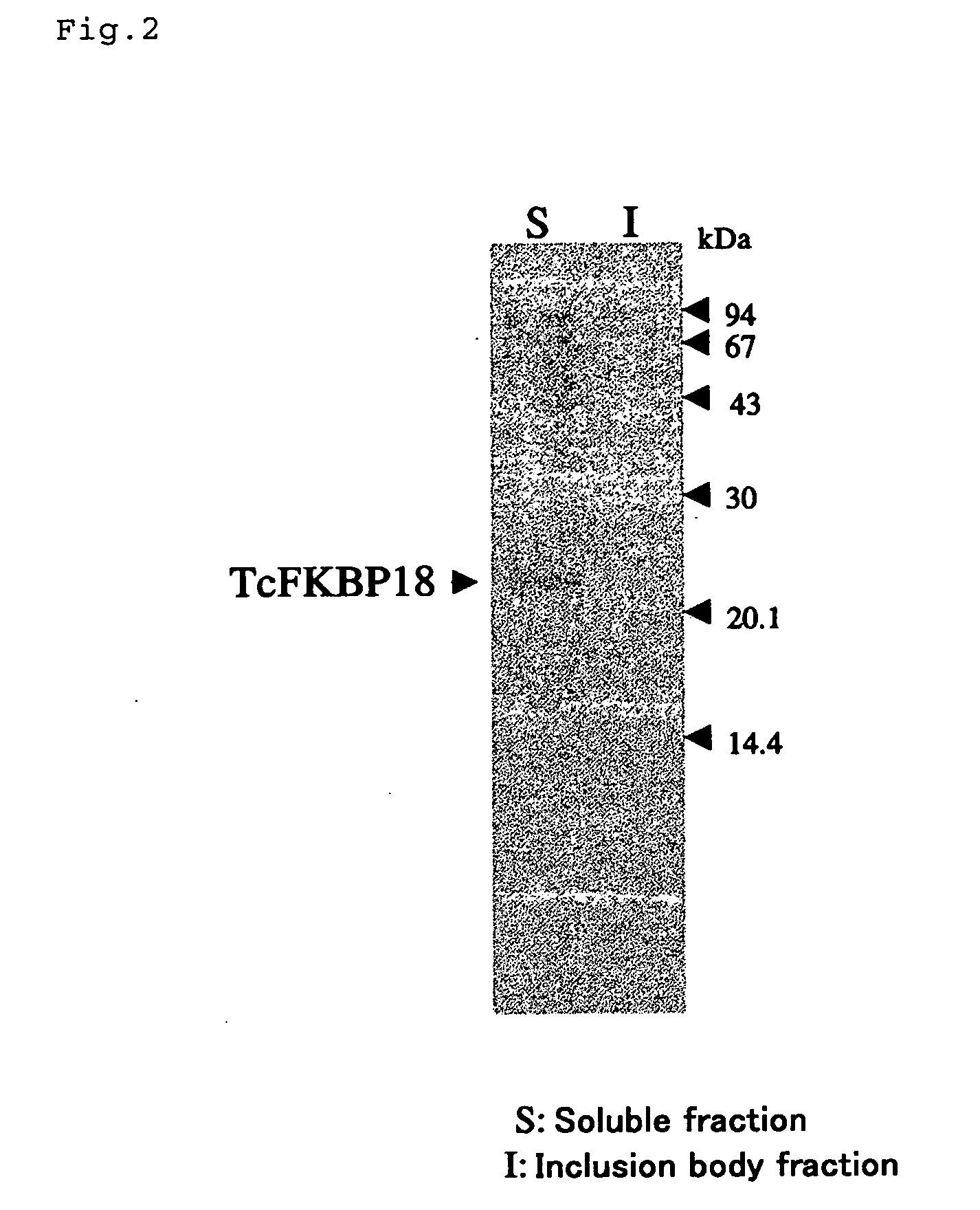Expression vector, host, fused protein, process for producing fused protein and process for producing protein
a technology of fused protein and expression vector, which is applied in the field of expression vector, host, fused protein, protein, etc., can solve the problems of low yield, long time, and low yield of antibodies
- Summary
- Abstract
- Description
- Claims
- Application Information
AI Technical Summary
Benefits of technology
Problems solved by technology
Method used
Image
Examples
example 1
(EXAMPLE 1) Construction of expression vector for fusion with the short type FKBP-type PPIase (TcFKBP18), which is derived from hyperthermophilic archaebacterium Thermococcus sp. KS-1
[0106] Using an expression plasmid pEFEl-3 (Iida, Gene 222, 249-, 1998) of TcFKBP18 (Ideno, Biochem. J. 357, 465-,2001) having molecular chaperone activity as a template, the TcFKBP18 gene fragment was amplified by a PCR method. By using TcFu-F1 and TcFu-R2 shown in Table 1 as a primer set for PCR, a restriction enzyme site was provided on both sides of the amplification product. On the other hand, as a nucleotide sequence encoding a linker for cutting TcFKBP18 fused protein into TcFKBP18 and a desired protein with a protease, Throm-F2 and its complementary chain were designed. Throm-F2 has a SpeI site on its 5′ side and an EcoRI site on its 3′ side, respectively (FIG. 1). Since Throm-F2 has a BamHI site and a NdeI site downstream of a DNA sequence of a thrombin cleavage site, a fused protein with TcFKB...
example 3
(EXAMPLE 3) Construction of expression vector for fusion with human FKBP 52-type PPIase
[0109] In order to construct an expression vector for fusion with human FKBP52-type PPIase(hFKBP52), a FKBP52 gene removing a termination codon was amplified by PCR from a human cDNA library. By using FK52-F1 and FK52-R1 shown in Table 1 as a primer set for PCR, restriction enzyme sites were provided on both sides of the amplification product. After insertion of the PCR product into a pT7 blue T vector, it was confirmed that a sequence is not different from registered information. On the other hand, the vector in which a TcFKBP18 gene was removed by treating TcFKfusion2 prepared in Example 1 with NcoI / SpeI, was purified by agarose gel electrophoresis. The pT7 blue T vector comprising a hFKBPS2 gene was treated with NcoI / SpeI, and a fragment of an excised hFKBP52 gene was recovered. The resulting hFKBP52 gene fragment and the aforementioned vector were ligated to recover a vector comprising a full ...
example 4
(EXAMPLE 4) Construction of expression vector for fusion with human CyP40-type PPIase
[0110] In order to construct an expression vector for fusion with human CyP40-type PPIase (CyP40), a hCyP40 gene removing a termination codon was amplified by PCR from a human cDNA library. By using CP40-F1 and CP40-R1 shown in Table 1 as a primer set for PCR, restriction enzyme sites were provided on both sides of the amplification product. After insertion of the PCR product into a pT7 blue T vector, it was confirmed that a sequence is not different from registered information. On the other hand, TcFKfusion2 prepared in Example 1 was treated with NcoI / SpeI, and the vector from which a TcFKBP18 gene had been removed, was purified by agarose gel electrophoresis. The pT7 blue T vector comprising a hCyP40 gene was treated with NcoI / SpeI, and an excised hCyP40 gene was recovered. The resulting hCyP40 gene and the aforementioned vector were ligated, and a vector comprising a full length hCyP40 gene was r...
PUM
 Login to View More
Login to View More Abstract
Description
Claims
Application Information
 Login to View More
Login to View More - R&D
- Intellectual Property
- Life Sciences
- Materials
- Tech Scout
- Unparalleled Data Quality
- Higher Quality Content
- 60% Fewer Hallucinations
Browse by: Latest US Patents, China's latest patents, Technical Efficacy Thesaurus, Application Domain, Technology Topic, Popular Technical Reports.
© 2025 PatSnap. All rights reserved.Legal|Privacy policy|Modern Slavery Act Transparency Statement|Sitemap|About US| Contact US: help@patsnap.com



